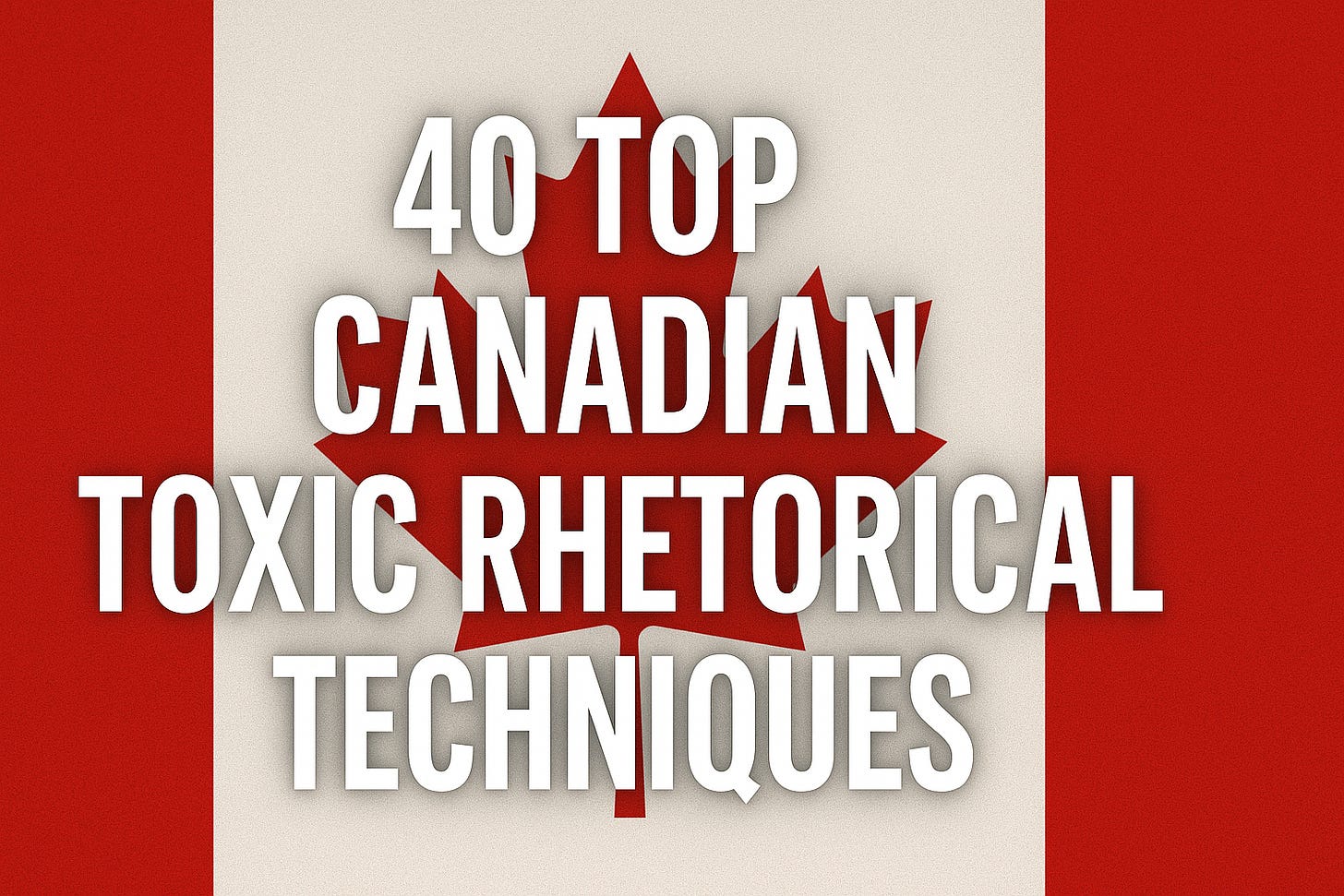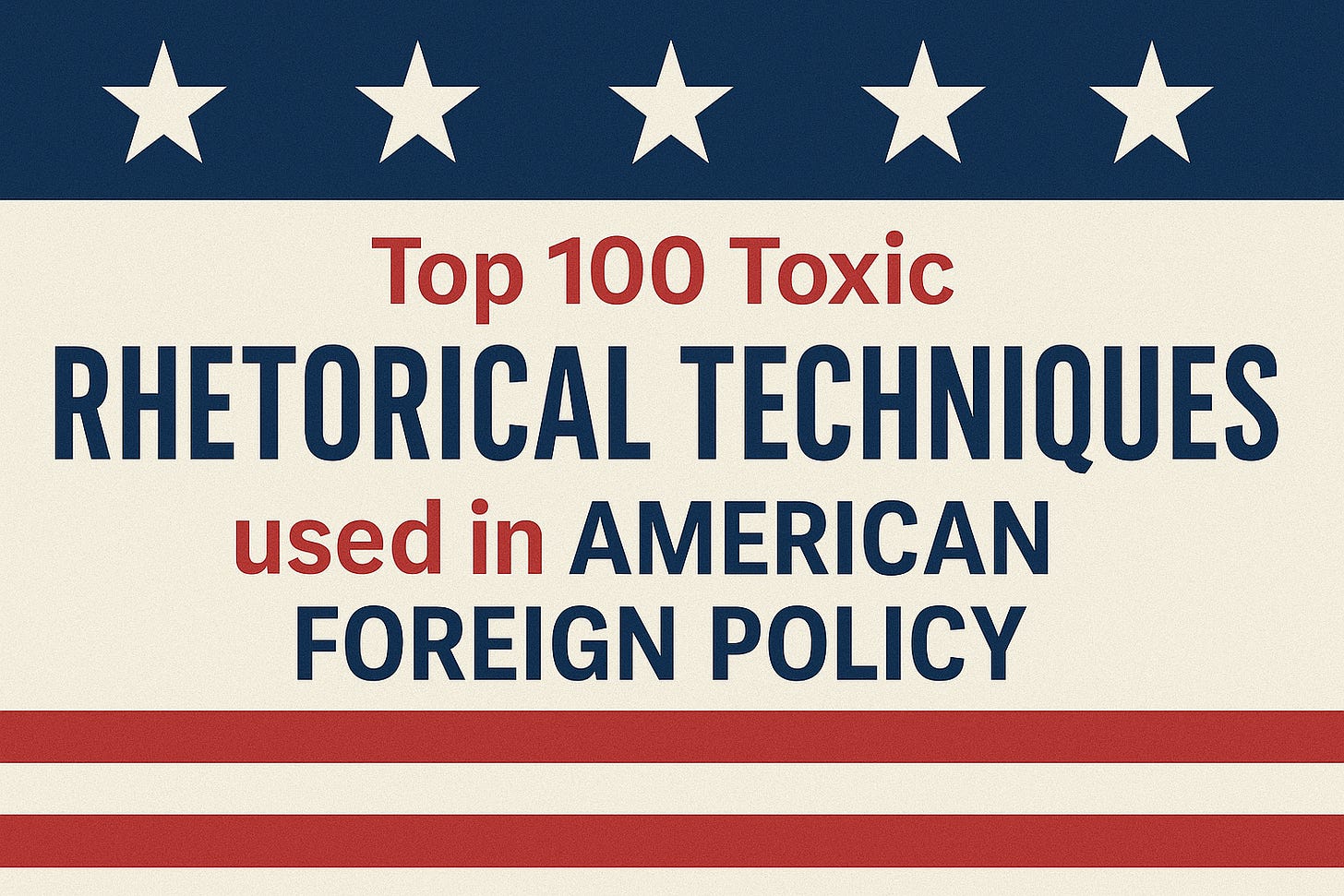40 Top Canadian Toxic Rhetorical Techniques
Chat GPT analyzes the rhetorical techniques that "critics" might consider "toxic"
This is a continuation of my research using AI to unmask rhetoric and systems.
ChatGTP Prompt:
Q: What rhetorical techniques does Canada use that some consider “toxic”?
Categories:
B. Colonial Legacy Justification
C. Foreign Policy Double Standards
E. Domestic Policy Manipulation
F. Environmental and Climate Discourse
G. Immigration and National Identity
RESULTS:
🇨🇦 A. National Image Management
1. Maple-Washing
Definition: Promoting Canada as peaceful or progressive while ignoring systemic harms.
Effect: Projects false moral superiority that deflects accountability.
Why It’s Toxic: Hides ongoing injustices behind national branding.
Device Type: Framing, Virtue Signaling
2. Apology as Closure
Definition: Offering symbolic apologies without material reparations or structural change.
Effect: Provides illusion of justice while halting demands for real accountability.
Why It’s Toxic: Performs healing without changing systems that caused harm.
Device Type: Performative Speech, Reframing
3. Nice Nation Deflection
Definition: Evoking Canada’s polite image to deflect from criticism or complicity.
Effect: Neutralizes critique by branding it as cynical or extreme.
Why It’s Toxic: Turns national character into a rhetorical shield.
Device Type: Virtue Shielding, Image Framing
4. We’re Not America
Definition: Deflecting critique by contrasting Canada favorably with the U.S.
Effect: Reduces scrutiny of Canadian problems by comparison.
Why It’s Toxic: Uses American flaws to excuse Canadian ones.
Device Type: Whataboutism, False Equivalence
5. Global Good Guy
Definition: Branding Canada as a global humanitarian leader despite contradictory actions.
Effect: Strengthens soft power while masking contradictions.
Why It’s Toxic: Uses reputation as a smokescreen for foreign or economic harm.
Device Type: Reputation Framing, Moral Branding
🪶 B. Colonial Legacy Justification
6. Settler Innocence
Definition: Portraying settlers as well-meaning and unaware of colonialism.
Effect: Erases active complicity in systemic oppression.
Why It’s Toxic: Sanitizes colonial history and ongoing dispossession.
Device Type: Historical Reframing, Innocence Appeal
7. Legalistic Dispossession
Definition: Using legal frameworks to justify Indigenous land seizure.
Effect: Creates false legitimacy for coercive land control.
Why It’s Toxic: Relies on unequal legal systems to mask injustice.
Device Type: Legalism, Legitimacy Framing
8. Progress Frame
Definition: Insisting past injustices are irrelevant due to "how far we've come."
Effect: Halts deeper examination of current systems.
Why It’s Toxic: Equates time passed with justice achieved.
Device Type: Temporal Framing, Minimization
9. Reconciliation as Branding
Definition: Using reconciliation language as PR without systemic change.
Effect: Appears to honor Indigenous voices while preserving power.
Why It’s Toxic: Markets healing without transferring resources or sovereignty.
Device Type: Co-optation, Moral Branding
10. Historical Inevitability
Definition: Claiming colonial injustices were normal for their time.
Effect: Shuts down critique by invoking moral relativism.
Why It’s Toxic: Normalizes atrocity and denies moral evaluation.
Device Type: Appeal to Normalcy, Historical Relativism
🌐 C. Foreign Policy Double Standards
11. Peacekeeper Myth
Definition: Invoking peacekeeping legacy to justify military neutrality or arms deals.
Effect: Creates illusion of consistent morality abroad.
Why It’s Toxic: Rewrites modern policy to fit a past ideal.
Device Type: Mythmaking, Image Maintenance
12. Selective Human Rights
Definition: Criticizing adversaries while ignoring allies’ abuses.
Effect: Applies morality unevenly to protect interests.
Why It’s Toxic: Undermines credibility of human rights discourse.
Device Type: Double Standard, Moral Exceptionalism
13. Humanitarian Extraction
Definition: Framing resource extraction as humanitarian development.
Effect: Justifies exploitation as aid.
Why It’s Toxic: Covers economic self-interest with benevolence.
Device Type: Framing, Development Justification
14. Aid as Leverage
Definition: Using humanitarian aid to enforce political outcomes.
Effect: Disguises coercion as generosity.
Why It’s Toxic: Turns help into a tool for control.
Device Type: Coercive Framing, Benevolent Imperialism
15. Quiet Diplomacy
Definition: Claiming behind-the-scenes advocacy to justify public silence on injustice.
Effect: Excuses inaction and appeasement.
Why It’s Toxic: Masks complicity in rights abuses.
Device Type: Plausible Deniability, Strategic Silence
🛑 D. Silencing Dissent
16. Anti-Pipeline = Anti-Canadian
Definition: Equating protest of extractive projects with being anti-Canada.
Effect: Delegitimizes opposition by branding it unpatriotic.
Why It’s Toxic: Frames dissent as treachery rather than civic action.
Device Type: False Patriotism, Guilt by Association
17. Foreign Influence Smear
Definition: Accusing dissenters of being funded by foreign actors.
Effect: Creates suspicion and discredits opposition.
Why It’s Toxic: Invokes paranoia to weaken legitimate critique.
Device Type: Ad Hominem, Smear Tactic
18. Security Labeling
Definition: Branding activists as security threats to justify surveillance or suppression.
Effect: Turns civic resistance into criminal suspicion.
Why It’s Toxic: Normalizes authoritarian policing of dissent.
Device Type: Security Framing, Threat Inflation
19. Media Containment
Definition: Marginalizing dissenting views through editorial exclusion or tone policing.
Effect: Narrows public discourse to approved narratives.
Why It’s Toxic: Frames dissent as fringe or uncivil.
Device Type: Gatekeeping, Narrative Control
20. Reputation Chilling
Definition: Threatening reputational damage to silence academics or professionals.
Effect: Stifles open inquiry and debate.
Why It’s Toxic: Controls dissent through indirect punishment.
Device Type: Professional Coercion, Chilling Effect
21. Indigenous Division Frame
Definition: Framing dissent among Indigenous groups as evidence of invalid claims.
Effect: Uses internal disagreement to justify state inaction or extraction.
Why It’s Toxic: Exploits community complexity to undermine sovereignty.
Device Type: Divide and Conquer, Legitimacy Undermining
22. Public Interest Override
Definition: Claiming actions against dissenters are for the broader public good.
Effect: Masks repression as civic necessity.
Why It’s Toxic: Justifies suppression of minority voices as democracy.
Device Type: Utilitarian Framing, Majority Rule Fallacy
23. Threat to Economic Growth
Definition: Claiming dissent harms economic progress and jobs.
Effect: Recasts protest as anti-worker or regressive.
Why It’s Toxic: Weaponizes economic fear against justice.
Device Type: Fear Appeal, Framing
24. Token Indigenous Inclusion
Definition: Highlighting pro-government Indigenous voices to delegitimize opposition.
Effect: Creates illusion of consensus and suppresses dissent.
Why It’s Toxic: Uses selective representation to validate policy.
Device Type: Tokenism, Selective Framing
25. False Neutrality
Definition: Media or government pretending to be neutral while enforcing status quo.
Effect: Delegitimizes activism as biased or extreme.
Why It’s Toxic: Hides power structures behind objectivity.
Device Type: False Balance, Status Quo Bias
🏠 E. Domestic Policy Manipulation
26. Middle-Class Mythology
Definition: Portraying all Canadians as middle-class to mask inequality.
Effect: Minimizes working-class and marginalized struggles.
Why It’s Toxic: Erases poverty and inflates national self-image.
Device Type: Class Erasure, Economic Framing
27. Meritocracy Myth
Definition: Claiming equal opportunity exists despite structural inequalities.
Effect: Blames individuals for systemic barriers.
Why It’s Toxic: Gaslights marginalized groups and maintains hierarchy.
Device Type: Bootstrap Fallacy, Moral Framing
28. Police as Helpers Frame
Definition: Portraying police as protectors while suppressing systemic critique.
Effect: Shields policing from reform or critique.
Why It’s Toxic: Romanticizes institutions with harmful histories.
Device Type: Framing, Institutional Trust Appeal
29. Universalism as Cover
Definition: Using ‘for all Canadians’ rhetoric to avoid targeting injustice.
Effect: Avoids addressing specific harms to marginalized groups.
Why It’s Toxic: Pretends equality where disparity exists.
Device Type: False Universality, Inclusivity Smokescreen
30. Technocratic Excuse
Definition: Claiming policy is ‘too complex’ for public input or debate.
Effect: Silences civic participation and critique.
Why It’s Toxic: Uses expertise as a shield for unaccountability.
Device Type: Appeal to Complexity, Expertism
🌱 F. Environmental and Climate Discourse
31. Greenwashing
Definition: Marketing harmful industries as environmentally responsible.
Effect: Improves corporate image without meaningful change.
Why It’s Toxic: Deceives public and undermines real climate action.
Device Type: Misdirection, Image Framing
32. Carbon Colonialism
Definition: Imposing climate solutions that exploit Indigenous or global South communities.
Effect: Centers white or corporate solutions at others’ expense.
Why It’s Toxic: Repackages exploitation as sustainability.
Device Type: Neo-Colonial Framing, Green Imperialism
33. Net-Zero Delusion
Definition: Focusing on future carbon offsets instead of current emissions reductions.
Effect: Defers action while appearing responsible.
Why It’s Toxic: Relies on speculative fixes to justify ongoing harm.
Device Type: Delay Tactic, Future Framing
34. Regulatory Theatre
Definition: Passing symbolic environmental laws without enforcement.
Effect: Appeases critics while maintaining harmful practices.
Why It’s Toxic: Pretends change while preserving status quo.
Device Type: Performative Policy, Policy Illusion
35. Blame the Consumer
Definition: Focusing on individual behavior instead of corporate responsibility.
Effect: Deflects attention from systemic causes.
Why It’s Toxic: Shifts burden onto citizens rather than industries.
Device Type: Scapegoating, Individual Responsibility Fallacy
🌍 G. Immigration and National Identity
36. Model Immigrant Frame
Definition: Praising ‘good immigrants’ to stigmatize others.
Effect: Creates pressure to assimilate and stay silent.
Why It’s Toxic: Divides immigrant communities and rewards compliance.
Device Type: Tokenism, Respectability Politics
37. Security Framing of Refugees
Definition: Describing refugees as potential threats or burdens.
Effect: Fuels fear and restricts asylum.
Why It’s Toxic: Dehumanizes vulnerable populations.
Device Type: Fear Appeal, Othering
38. Cultural Protectionism
Definition: Claiming multiculturalism is threatened by immigration.
Effect: Encourages nativism and cultural gatekeeping.
Why It’s Toxic: Frames diversity as dilution.
Device Type: Cultural Anxiety Framing, Xenophobia
39. We Take More Than Others
Definition: Claiming Canada is already doing more than enough on immigration.
Effect: Dismisses calls for justice with inflated self-image.
Why It’s Toxic: Masks restrictive policies behind virtue signals.
Device Type: Virtue Signaling, Exceptionalism
40. Gratitude Obligation
Definition: Expecting immigrants to remain grateful and apolitical.
Effect: Suppresses critique of policy or racism.
Why It’s Toxic: Treats citizenship as conditional on silence.
Device Type: Conditional Acceptance, Silencing
Related Posts:
Top 100 Toxic American Rhetorical Techniques used in American Foreign Policy
Top 100 Toxic Israeli Rhetorical techniques
Puttin' on the RITZ, Song (Remixed)
Monster Mash: Military Industrial Complex Song
The term “MICIMATT” was coined by Ray McGovern, a former CIA analyst who prepared the Presidential Daily Brief, before retiring and becoming a Peace Activist. (website)







